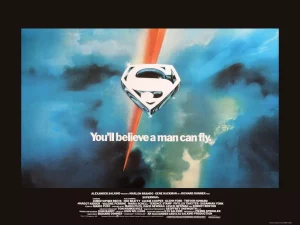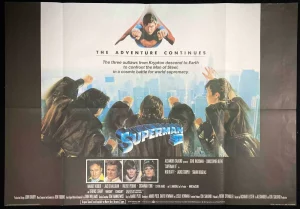WARNING: SPOILERS AHEAD!
This was an early article I wrote back in 2016 for the now-defunct website Cinema Jam. Given that we are expecting a new SUPERMAN film from James Gunn in 2025, it seems apt to publish this again as a prelude to the new film.
NOTE: This was published around the time that Zack Snyder’s BATMAN V SUPERMAN: DAWN OF JUSTICE was about to be released. Enjoy it in its’ (almost) full original glory.
As visual effects techniques have moved on from the late 1970s, it is such a pity that the Man Of Steel has not managed to evolve as much as some of the other classic comic book characters that have populated cinema and television screens over the last ten years.
Below: Original UK Quad poster for SUPERMAN – THE MOVIE

It all seemed a little simpler back in 1978 when Alexander and IIya Salkind,, then riding high on the success of the THREE MUSKETEERS films, starry vehicles that won audience and critical acclaim, created a grand plan to resurrect Superman for a new generation of film-goers.
Previously available in cliffhanger series and on radio, as well as in TV form with the likes of George Reeves and Kirk Alyn (who subsequently turned up with his co-star Noel Neill in an early sequence in the 1978 film), they recruited GODFATHER scribe Mario Puzo, David and Leslie Newman and Robert Benton (who went on to direct KRAMER VS. KRAMER (1979) to flesh out an epic script chronicling the evolution of the character from his time of Krypton to his arrival on Earth and beyond. Richard Donner, coming off the success of the classic horror film THE OMEN (1976) was recruited to helm the film.
In light of the extensive script and complexity of the production, the film was split into both an original and a sequel and shot simultaneously. Utilising locations in the USA, Canada, UK, France, amongst others, as well as interiors shot at Pinewood which encompassed the sets of the Fortress of Solitude, the Daily Planet, Lex Luthor’s
lair and a street scene that would dominate part of SUPERMAN II, there was no expense spared, not least in Marlon Brando‘s $3.5 million pay-cheque for 12 days work.
The late Tom Mankiewicz, who was credited as Creative Consultant on these films, said in a documentary on the DVD that SUPERMAN was never previewed, a rarity these days as a lot of the bigger blockbusters are previewed for an audience. It didn’t matter, as SUPERMAN (known as SUPERMAN – THE MOVIE in some territories including the UK)
became the Number One film in the US and UK and truly making audiences believe a man could fly. I remember the first time I saw the brilliant helicopter rescue sequence on the British Saturday morning show TISWAS in 1979 and the very first teaser trailer that simply was the shot POV from the front of a jet going at speed more than whetted the appetites of audiences across the world.
Watch the extended teaser trailer here:
There were bubblegum cards and comic books and the soundtrack, by Oscar-winning composer John Williams was released in a double-album (however, the copy our family received bizarrely contained a side which had the MECO versions of the STAR WARS and CLOSE ENCOUNTERS themes). The soundtrack is now available in an uncut special edition 2-CD set containing all the incidental music and out-takes, one of the joys of getting CD Soundtracks.
SUPERMAN II was far more complex, not least with the dismissal mid-production of Richard Donner after creative differences with the producers. Donner admitted in another documentary that if he had been left alone, he would have directed not only SUPERMAN and SUPERMAN II, but also SUPERMAN III, IV and beyond. It is a shame that he didn’t get the chance, as he would have created a wonderful legacy that would have been hard to beat.
Watch the SUPERMAN II trailer here:
The release on DVD of THE RICHARD DONNER CUT of SUPERMAN II brings up some interesting observations about what exactly the true version of the film is. The big difference between Richard Donner’s version and Richard Lester’s, who took over, is the opening sequence. In the Lester version, Superman detonates a bomb from the Eiffel Tower in space, whereas in the Donner version, the rocket he throws into space
from the end of the first film is the catalyst for releasing General Zod, Non and Ursa near Earth, in the process causing their quest for world domination.
If you do get a chance to watch and compare, you’ll see how much of Donner’s work remains in the DONNER CUT from the original theatrical version.
SUPERMAN II claimed top spot in 1981, beating FOR YOUR EYES ONLY and FLASH GORDON – plus the original movie starring Harrison Ford at a hero called Indiana Jones called RAIDERS OF THE LOST ARK (which claimed it’s audience in the UK on it’s reissues in 1982 and on it’s sell-through debut in 1983 where it became one of the first titles to sell for under 20 pounds.
Below: Original UK Quad poster for SUPERMAN II

So, exactly why has the Donner version of SUPERMAN remained the film to beat when it comes to any new adaptation of SUPERMAN? Well, as Donner has put it many a time, in a word – or his word – VERISIMILITUDE – keeping an essence of reality.
Bryan Singer‘s SUPERMAN RETURNS (2006) did come close in the early part of the film and the shuttle rescue in that movie was a well put together sequence, up there with the helicopter rescue in the 1978 version, but unfortunately the second half of the film paid a little too much homage to the Donner original, right down to the Brando moments, used with blessing from Donner. MAN OF STEEL was a little too dark with a lot of Christopher Nolan’s style integrated into the production.
Another key moment in the Donner film was when Jonathan Kent dies. In that version, Kent dies of a heart attack, prompting the young Clark (Jeff East) to say this:
“All those things I could do, all those powers – and I couldn’t even save him”
In MAN OF STEEL, it is a storm that claims Jonathan Kent (Kevin Costner), an impressive special effect, but with less of the potency of the 1978 moment. A lot of SUPERMAN – THE MOVIE‘s power comes from the grounded reality. Lex Luthor, as played by Gene Hackman, is a cunning and playful megalomaniac who has the right balance of dark humor and villainy, particularly when he catches Superman out with a lead box containing Kryptonite.
Earlier in the film, Lois Lane (Margot Kidder) interviews Superman, a clever and witty mix of humor, effects and flirtation (spoofed in HOT SHOTS with Charlie Sheen and Valeria Golino)
Possibly another reason why the later incarnations of SUPERMAN haven’t gone down as spectacularly as expected is they perhaps keep it a little too real. One of the best loved moments in SUPERMAN II is when our hero relinquishes his powers for the love of Lois Lane and comes a cropper in a road-side diner with a trucker, just before the President comes on TV to renounce his power to General Zod. Zod as portrayed by Terence Stamp is a more majestic villain with wonderful injections of humor and intelligent logic, as demonstrated in this exchange between him and Ursa as one of the first battles happens involving a helicopter blasting them with rockets.
URSA: Look…they need machines to fly
ZOD: What bravery. Be nice to them my dear, blow them a kiss
Cue Ursa creating a stormy gust of wind that causes the helicopter to crash.
It is very much some of these moments that has helped the first two films to endure to this day. Even though the effect techniques have dated somewhat (even more apparent on the third and fourth films, of which the latter film was reduced to location work in Milton Keynes of all places by the Cannon Group), the essence of the character has endured. The suits in the earlier films seem a bit brighter than the ones worn by Brandon Routh and Henry Cavill.
The helicopter rescue in SUPERMAN – THE MOVIE, created by UK FX legends Roy Field and Derek Meddings, plus the Zoptic process of flight for Christopher Reeve pioneered by Zoran Perisic, was a great mix of matte, front / back projection and great acting from Christopher Reeve, who used very specific movements to create the illusion of flight.
With the release of the James Gunn entry, one hopes that some of the spirit of the Donner films is carried over more effectively – a style that drew audiences and fans to the character four decades ago. At its’ legacy’s heart is the now-legendary performance by Reeve himself, celebrated in the recent BAFTA-winning documentary SUPERMAN: THE CHRISTOPHER REEVE STORY.
Watch the trailer here:


